Our Doctoral Candidates
 Name: Giovanny Andrés López Muñoz (Colombia)
Name: Giovanny Andrés López Muñoz (Colombia)
Topic: Integration of power systems based on directly-fired oxycombustion sCO2power cycles (WP1)
Academic host: Universidad de Sevilla (Spain)
Industry host: Empresarios Agrupados International (Spain)
Secondment:Técnicas Reunidas (Spain)
Academic Supervisors: Prof. David Sánchez, Dr. Francesco Crespi
Short Bio: Since I was a kid, my fascination with the mechanics of everyday things propelled metowards a lifelong journey in understanding and transforming the world around us. Thisinnate curiosity, coupled with my love for mathematics and physics, steered metowards becoming a Mechanical Engineer. My journey in the field of energy has beenenriched by education in Colombia and Spain, coupled with hands-on experienceexecuting R&D projects. Now, as I embark on a PhD program focused on the Integrationof power systems based on directly-fired oxycombustion sCO2 power cycles, I amdriven by the belief that sustainable energy solutions are key to overcoming thechallenges that lie ahead. If not an engineer, I would have chosen the path of amathematician. Beyond my professional pursuits, my passion for music, love for soccer,and appreciation for cinema shape my versatile character. I eagerly anticipatecontributing to the iSOP project, where my diverse interests converge towards acommon goal: making the world a more sustainable place
Current activities and progress updates
The Air Separation Unit (ASU) plays a crucial role in oxy-combustion directly fired supercritical CO2 (sCO2) power cycles, providing the high-purity oxygen required for combustion. However, its high energy consumption significantly impacts overall efficiency. Current studies reveal discrepancies between software-based ASU models and reported industrial values, highlighting the need for a detailed, component-level approach. This research develops a comprehensive thermodynamic model to accurately predict ASU power consumption and explore integration strategies with sCO2 cycles.
A key aspect of the study focuses on oxygen production technologies, comparing available oxygen production methods. While cryogenic separation remains the dominant choice for large-scale applications due to its ability to produce high-purity oxygen, process optimization is essential to improve efficiency. The impact of key parameters on the distillation column performance is analyzed, providing valuable insights into separation effectiveness.
Furthermore, a methodology for thermodynamic assessment and comparison of different directly fired sCO2 power cycles was developed and will be presented at the 8th International Seminar on ORC Power Systems (ORC 2025).
Beyond steady-state modeling, the research also extends to the dynamic behavior of sCO₂ cycles. Strengthening inter-work package collaboration, dynamic modeling and control strategies are being developed in collaboration with DC07 to ensure stable and flexible operation. The work will be also presented at ORC 2025. These contributions aim to provide a deeper understanding of ASU integration and its impact on high-efficiency, low-emission power cycles, offering practical solutions for next-generation energy systems.
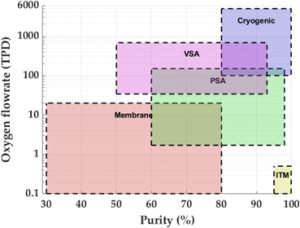
Most suitable Air Separation Technology according to required flow rate and purity.

Influence of Feed Location on Oxygen Composition.
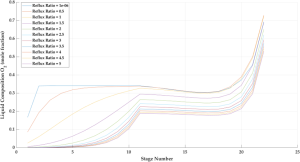
Influence of Reflux Ratio on Oxygen Composition
 Name: Amgad Abdelnaser Abdelrahman Khamis (Egypt)
Name: Amgad Abdelnaser Abdelrahman Khamis (Egypt)
Topic: Market uptake of supercritical CO2power systems to enable carbon-neutralityby 2050 (WP1)
Academic host: Universidad de Sevilla (Spain)
Industry host: ETN Global (Belgium)
Global
Secondment: AzzeroCO2 (Italia)
Academic Supervisors: Prof. David Sánchez, Dr. Francesco Crespi
Short Bio: As a dedicated Ph.D. student at ISOP, a Marie Curie Program for doctoral researchers, I am passionately engaged in researching the market up take of supercritical CO2 power systems to facilitate carbon-neutrality by 2050. My academic journey started by earning a Bachelor’s degree in Mechanical Engineering from Sapienza University in Rome. Subsequently, a master degree at the polytechnic of Turin in the same field. My Master’s thesis, conducted during an internship at Ethos Energy, focused on creating digital twin simulations for heavy-duty gas turbines, utilizing innovative software solutions. Professionally, in the same company I served as a Gas Turbine Design Engineer, contributing significantly to the modeling and optimization of gas turbine components. As I progress in my Ph.D., I remain driven by a passion for sustainable energy solutions, a commitment to continuous learning, and an eagerness to contribute to the scientific community. Outside academia, I enjoy fostering cross-cultural relationships, showcasing my flexibility and engaging in creative problem-solving. With a solid foundation in engineering, a diverse skill set, and a keen eye for detail, I am poised to make impactful contributions to the scientific landscape
Current activities and progress updates
Accurate forecasting of electricity load and price is essential for the efficient operation of power generation and energy storage systems, particularly in volatile energy markets. This study evaluates various machine learning models, including Long Short-Term Memory (LSTM), Extreme Gradient Boosting (XGBoost), Convolutional Neural Networks (CNN), hybrid CNN-LSTM, and Gated Recurrent Units (GRU), applied to the Spanish electricity market. Using a dataset spanning nine years of hourly data, these models are trained and assessed based on multiple error metrics: Mean Absolute Error (MAE), Mean Absolute Percentage Error (MAPE), and Root Mean Squared Error (RMSE). These metrics provide a comprehensive evaluation of forecasting accuracy, helping to determine the best-performing models.
The forecasting results are presented in the provided image, where the model’s ability to capture price trends over different weeks is visualized. The first week of forecasting demonstrates a high level of accuracy in trend prediction, but deviations become apparent in the second week, such findings emphasize the importance of selecting appropriate models for different timeframes to minimize forecasting errors.
Additionally, performance metrics for various forecasting models are analyzed, as presented in the second image. The results highlight that CatBoost and Random Forest achieve the lowest RMSE values of 27.646 and 27.896, respectively, with high correlation scores exceeding 0.86. Gradient Boosting and XGBoost also perform well, whereas traditional models like SARIMAX and Prophet exhibit significantly higher RMSE values of 38.786 and 58.866, respectively, with lower correlation scores. These findings indicate that ensemble learning methods, particularly tree-based models, outperform traditional statistical forecasting techniques in this context.
The broader objective of this research is to enhance decision-making in energy market operations by improving load and price predictions. Given the dynamic nature of electricity markets, better forecasting tools can support investments in large-scale energy storage and trading strategies, reducing the risks associated with market volatility. The study also aims to develop an automated forecasting tool that optimally selects the best model for each forecast horizon, ensuring improved reliability and profitability in energy trading.
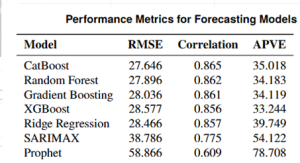

The model manages to capture the trend of the actual price and the values with a good precision as we see in week 1 of forecasting that start on the 24th of June, but for the first of July/ unfortunately this is not always the case as we can see in the plot of week2. Next step consists in understanding where the errors arise from and if they are evitable
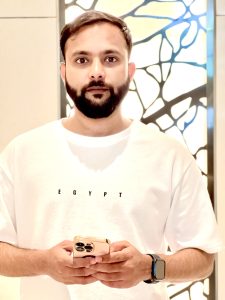 Name: Babras Khan (India)
Name: Babras Khan (India)
Topic: Integration of power systems based on indirect supercritical Carbon Dioxide power cycles (WP1)
Academic host: Czech Technical University in Prague (Czech Republic)
Industry host: Empresarios Agrupados International (Spain)
Secondment: INERCO (Spain)
Academic Supervisors: Prof. Vaclav Dostal
Short Bio: I am an eclectic being, thriving at the intersection of science and creativity. Growing up in India’s bustling city, I developed a deep fascination with science, inspired by the mysteries of the universe and the boundless potential of the human mind. This curiosity fueled a lifelong dedication to exploring scientific phenomena.
My academic journey began with a bachelor’s degree in mechanical engineering, where I honed diverse skills and developed a keen interest in thermodynamics and power system design. This led me to pursue a master’s degree in mechanical engineering in South Korea, where I delved into a project titled «Thermodynamics Analysis of a Novel CHP System Powered by Recuperative ORC.» I also actively participated in various conferences and seminars, further enriching my knowledge.
My academic pursuits have always coexisted with other passions. I am an avid reader, a passionate cook, and a traveler. Each of these pursuits acts as a source of solace and inspiration, fostering my creativity and resilience.
As a researcher, my ambition is to understand the world and make meaningful contributions to effecting positive change. I hold steadfastly to my values and firmly believe in the transformative power of ideas. As a proud member of ISOP, I am eager to leverage my expertise and skills to drive impactful research.
Current activities and progress updates
🔬 Research Spotlight: Advancing Nuclear Cogeneration with Supercritical CO₂
Babras Khan’s research focuses on the integration of power systems based on indirect supercritical Carbon Dioxide (sCO₂) power cycles, paving the way for more efficient and cleaner energy solutions.
As part of his work, he has developed and modeled a high-temperature nuclear cogeneration system utilizing sCO₂ for enhanced thermal efficiency. His results, validated through the GEMINI+ project (European Union) at Czech Technical University, demonstrate promising applications in optimizing the design and operation of nuclear-driven thermal power plants.
His research offers a valuable framework for improving thermal power systems and aligns with key initiatives such as NC2I-R and Gemini+, aimed at fostering sustainable and efficient energy generation. With potential real-world industrial applications, these advancements could play a crucial role in the transition towards cleaner energy solutions.
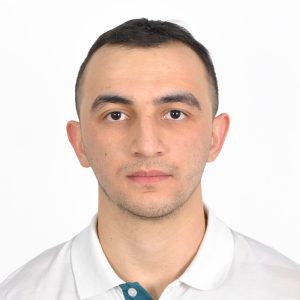 Name: Sukhrob Shakirov (Uzbekistan)
Name: Sukhrob Shakirov (Uzbekistan)
Topic: Large Scale Energy Storage based on sCO2 systems (WP1)
Academic host: Technischen Universität Wien (Austria)
Industry host: ETN Global (Belgium)
Secondment: Energy and Turbine Network (Belgium)
Academic Supervisors: Prof. Markus Haider, Prof. Andreas Werner
Short Bio: I’m a renewable energy engineer with experience in IT and a deep dive into renewable technologies, including utility-scale solar (PV and CSP), residential PV and solar thermal collector systems, CFD.
I have a BSc in Mechanical Engineering from Polytechnic University of Torino. After, I worked as a testing automation engineer in the IT sector, crafting testing frameworks with JavaScript.
However, my true passion lay in renewable energy, guiding me to the InnoEnergy Master’s School for Renewable Energy through a scholarship. At KTH Royal Institute of Technology in Stockholm and later at UPC Polytechnic University of Catalonia in Barcelona, I fully embraced renewable energy studies. My work culminated in a significant final project: a techno-economic assessment of leveraging Concentrated Solar Power (CSP) plants for direct air carbon capture. This project not only marked a pinnacle in my academic journey but also underlined my commitment to contributing meaningful, innovative solutions in the renewable energy landscape.
Currently, I’m a Project Assistant and PhD candidate at TU Wien, involved in the ISOP project. We’re developing innovative system integration concepts for large-scale energy storage systems utilizing sCO2 power cycles, expanding my contribution to green technologies
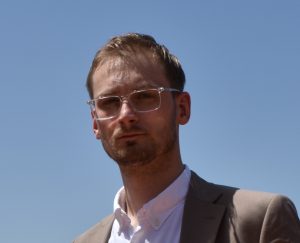 Name: Matej Jerabek (Czech Republic)
Name: Matej Jerabek (Czech Republic)
Topic: Operation of power systems based on indirect sCO2 power cycles (WP2)
Academic host: Czech Technical University in Prague (Czech Republic)
Industry host: Baker Hughes (Italy)
Secondment: Doosan Skoda Power (Czech Republic)
Academic Supervisors: Prof. Vaclav Dostal
Short Bio: I’ve always been interested in how things work. I’ve never been a «just do it and don’t think about it» kind of person. When I was in high school my interest in physics waned a bit because I didn’t really have teachers to look up to. That all changed when I got to college. Thermomechanics, fluid mechanics and similar subjects quickly became my favorite. I knew right away that even if I didn’t do it for a living someday, I would always think of the world that way. I was very fortunate that practically right after I finished my master’s degree, I was offered a job in the department I had graduated from, the department of design of power systems and equipment at the University of West Bohemia in Pilsen. From day one, I was involved in a number of projects and research activities. Working at the university has given me a lot of valuable experience and I really appreciate it. My family says that my enthusiasm for physics is contagious and I try to pass this attitude on to others, whether they are my students, friends or colleagues. I love physics and always will, and I am very grateful that my hobby has
become my profession.
Current activities and progress updates
Matěj Jeřábek recently achieved an important milestone by submitting a comprehensive article on the sCO2 conference held in Delft, Europe. The primary aim of this study was to assess the transient response of the cycle when it experienced a step change in flue gas temperature, which is considered as a heat source in this context. Through careful analysis and modeling, the study showed a very good ability to predict this behavior. The findings provide valuable insights into the operational dynamics of sCO2 cycles and improve the understanding of their efficiency and response characteristics under different conditions. The current literature does not contain a broad range of transient simulations that could provide comprehensive insights. Often existing studies focus solely on dynamic cycle responses lacking a thorough examination of accompanying control systems. This gap is significant as understanding the interplay between dynamics and control is crucial for practical applications. Therefore, the goal is to systematically fill these gaps in the literature by developing a robust control scheme tailored for clearly defined scenarios ultimately enhancing the understanding and performance of transient simulations in various conditions. The current study serves as a foundational basis for further research in this particular area of investigation and exploration.
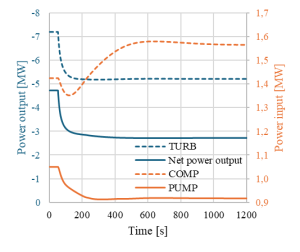
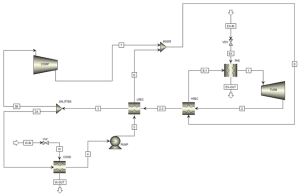
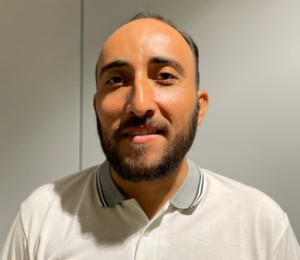 Name: Ihtishamul Haq (Pakistan)
Name: Ihtishamul Haq (Pakistan)
Topic: Operation of power systems based on directly-fired sCO2 power cycles with carbon capture (WP2)
Academic host: Technischen Universität Wien (Austria)
Industry host: Baker Hughes (Italy)
Secondment: SoftInWay (Switzerland)
Academic Supervisors: Prof. Markus Heider, Dr. Andreas Werner
Short Bio: My name is Ihtishamul Haq. I am a highly motivated mechanical engineer graduated from the most prestigious institute of Pakistan, GIK Institute of Engineering Sciences and Technology. I have a good background in Thermal Systems Modelling, Waste to Useful Conversion and Energy Systems.
In my previous studies, I worked on different projects related to Thermodynamics and Thermal Systems. One of the projects was about efficient and environmentally friendly conversion of solid fuel (Coal) into useful chemicals.
Currently, I’m a member of the ISOP community and working on a project entitled «Operation of directly-fired supercritical CO2 power generation systems» funded by the Horizon program of the European Commission.
Apart from my professional life, I like to engage myself in sports and social activities, in sports, particularly, I like to play cricket, football and table tennis that always keep me energetic and refreshed.
I’m here on LinkedIn to help answer questions or provide information to the best of my ability. Feel free to ask!
Current activities and progress updates
Literature gaps
- Direct-fired sCO2 power generation system exhibits lower performance in case of off-design operation.
- Mostly in the literature the direct-fired power generation systems were analyzed under steady state conditions, providing limited insight into real-time system performance.
- Components such as combustor, turbine, and recuperator are mainly responsible for the losses.
- In previous studies, the power consumption of ASU was considered as a single source.
- Maintaining the stability of the working fluid is critical for system operation, highlighting the need for advanced control strategies to ensure optimal performance and avoid damage to the components.
Solutions and strategies
- Define the operational strategies for directly-fired sCO2 power systems in off-design operation.
- Assess and define the constraints set by the operational strategies on the design specifications of major equipment.
- Integration of the ASU with power cycle to minimize energy losses and optimize efficiency.
- Define the exceptional operating procedures of directly-fired sCO2 power for start-up, shut-down and emergency shut-down.
Status of the research and main results
The steady state thermodynamic study of four different directly-fired oxy-fuel combustion power cycles: SCOC-CC, Matiant cycle, Graz cycle, and Allam power cycle, has been completed as follows:
– Process modelling and simulation by using Aspen Plus
– Consideration of the ASU and CCS
– Simulated with same input and boundary conditions
– Performed energy and exergy analysis
– Sensitivity analysis
Results: Allam power cycle is selected as a reference cycle for dynamic analysis due to high its high energy and exergy efficiency.
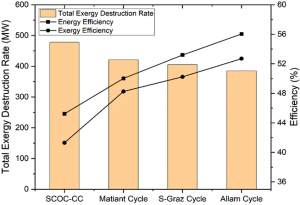
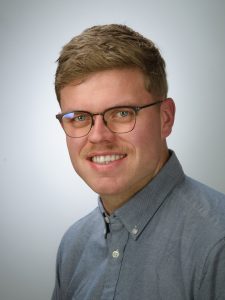
Name: Leonard Muke (Germany)
Topic: Dynamic operation of sCO2 power generation systems under variable load and variable energy input (WP2)
Academic host: Universidad de Sevilla (Spain)
Industry host: SoftInWay (Switzerland)
Secondment: Doosan Skoda Power (Czech Republic)
Academic Supervisors: Prof. David Sánchez, Prof. Lourdes García
Short Bio: Hello! My name is Leonard Muke from Germany and I am a Doctoral Candidate within the ISOP program for DC07, researching the transient simulation of sCO2 power cycles at the University of Seville and SoftInWay. Before that, I studied mechanical engineering at the University of Duisburg-Essen and worked at a turbine manufacturer in Germany, where I constructed gas turbine components. During that time, I also spent four months in Seville for an Erasmus-semester, where I got to know the city and decided to come back for the PhD.
I grew up at a farm in the countryside in the north-western part of Germany, close to the Dutch border. Because of this, I am still connected to rural life and like to spend time in nature, on hiking trails and in the mountains. Besides that, I like to go running, play Ultimate Frisbee at a local Frisbee Team in Seville and go bouldering.
I look forward to the next three years of research on this important and interesting topic. Together with my fellow doctoral candidates, we will conduct important and profound research on sCO2 power cycles. This will not only be an important step for me, but also sets the starting point for a future career in sCO2 turbomachinery.
Current activities and progress updates
The development of a dynamic model for a supercritical carbon dioxide (sCO2) cycle is essential for improving the efficiency, reliability, and control of energy systems, particularly in power generation and waste heat recovery. Unlike steady-state models, which provide only a fixed operational snapshot, dynamic models capture transient behaviors, making it possible to analyze system responses to changing conditions such as load variations, startup, and shutdown sequences. This deeper understanding is crucial for optimizing performance, refining control strategies, and ensuring stable operation under real-world conditions.
To create an effective dynamic model, several important steps must be taken. First, a solid thermodynamic foundation must be established, with an accurate representation of sCO2 properties across varying pressures and temperatures. The next step is detailed component modeling, including turbines, compressors, heat exchangers, and recuperators, with governing equations for mass, energy, and momentum conservation. Numerical methods are then required to solve these equations reliably, ensuring that transient effects are accurately captured. In addition to these technical aspects, addressing research gaps is critical—particularly in areas such as startup simulation, control system development, and transient behavior modeling. A major challenge is ensuring that the model aligns with real-world behavior, which requires rigorous validation against experimental data. By comparing simulated results with actual system performance, the model can be refined and adjusted, enhancing its predictive capability. A well-developed dynamic model ultimately serves as a powerful tool for optimizing sCO2 systems, improving operational flexibility, and advancing energy technology.
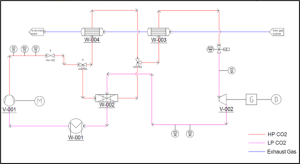
P&ID diagram of the cycle.
As a result, several disseminations are planned. First, a combined optimization of a sCO2 cycle with a gas turbine under the consideration of achieving the highest possible efficiency is explained in a submitted paper for ASME Turbo Expo, in collaboration with DC2 and DC17. Moreover, submissions of the development of the dynamic model with the control logic are planned for KCORC, in collaboration with DC1. These contributions focus on a better understanding of the dynamic cycle behavior of the system, thus enabling a secure, efficient and stable operation of the system.
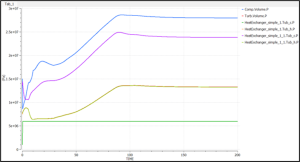
Dynamic pressure behavior of the cycle.

Name: Reem Ahmed (Egypt)
Topic: Control strategies and optimisation of control of sCO2 power generation systems for direct and indirect heating configurations (WP2)
Academic host: Brunel, University of London (UK)
Academic Supervisors: Prof. Abdulnaser Sayma, Jafar Al-Zaili.
Short Bio:
During the last three years before recruitment, my primary place of residence and main
activity was in Egypt. I completed my dual B.Sc. degree in Mechanical Engineering from the British University in Egypt and London South Bank University (LSBU).
From October 2021 to October 2022, I worked as a Research Assistant at the Centre for Simulation, Innovation, and Advanced Manufacturing (SIAM) at the British University in Egypt (BUE). In this role, I actively engaged in various research activities, including literature reviews, experimental and computational analysis of diMerent physical systems, writing research papers, and developing research proposals.
Additionally, I worked as a Graduate Research and Teaching Assistant at The British University in Egypt from October 2022 to October 2023. I started working towards my M.Sc. degree in the Renewable Energy Engineering Program in September 2022, which has received approval from both London South Bank University (LSBU) and the British University in Egypt (BUE). I am currently in the process of finalizing my M.Sc. thesis.
Current activities and progress updates
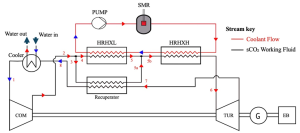
- Research Status:
The research is progressing towards the targeted development of an advanced control strategy optimized for the transient phases of a 30 MWe split – reheat sCO2 power cycle. The project’s primary focus is on enhancing operational control during startup, shutdown, and emergency scenarios, which are critical for maintaining system integrity and safety.
- Main Achievements:
– Model Validation: The steady-state model of the 30 MWe split reheater sCO2 power cycle has been successfully completed and validated, now accurately reflecting its operational characteristics.
– Off-Design Model Development: An off-design model, capable of simulating varying operational conditions, has been developed, paving the way for more adaptive control strategies.
– Control Strategy Implementation: A tailored control strategy for the off-design model is currently being implemented, setting the stage for robust management during variable operational states.
- Future Work:
The development of transient models is being planned, with the integration of both traditional and advanced control strategies being anticipated. This initiative is aimed at significantly enhancing operational management during transient phases, ensuring higher efficiency and safety.
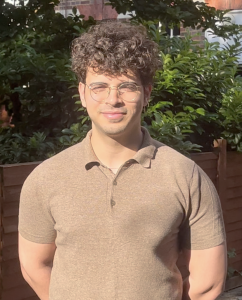
Name: Mohammed Alnajjar (Palestine)
Topic: Fundamental studies to enhance off-design performance of megawatt scale sCO2 compressors (WP3)
Academic host: Brunel, University of London (UK)
Academic Supervisors: Prof. Abdulnaser Sayma, Dr. Tala El-Samad
Short Bio: I am Mohammed Alnajjar, 24 years old, from Gaza, Palestine. I graduated from the mechanical engineering department at Istanbul Technical University in Turkey, with a focus on Computational fluid mechanics and turbomachinery. Currently, I am a doctoral candidate at City university of London, as a part of the ISOP project. I am working on optimizing the off-design performance of megawatt scale supercritical carbon dioxide compressors. Aside from engineering, I enjoy reading, theatre, and cooking.
The motivation for developing axial compressors for the supercritical CO₂ Brayton cycle stems from the cycle’s potential for high thermal efficiency, compact size, and improved economics in power generation, particularly for applications such as nuclear reactors, concentrated solar power (CSP), and waste heat recovery. Unlike conventional working fluids, sCO₂ exhibits unique thermodynamic properties near its critical point, resulting in a dramatic reduction in compressor work due to its high density. However, designing an efficient axial compressor for sCO₂ is challenging due to sharp variations in fluid properties, high Reynolds numbers, and potential phase change issues near the critical point. Compared to radial compressors, axial designs offer advantages in higher flow rates, lower stage pressure ratios, and scalability for large-scale power systems, making them crucial for commercializing the sCO₂ Brayton cycle.
Studying the design and off-design performance of axial compressors is critical for optimizing overall cycle efficiency because compressor inefficiencies can significantly impact net power output. Accurately modelling and optimizing compressor behaviour under varying conditions ensures stable operation, minimizes power losses, and enhances cycle adaptability, particularly in dynamic energy systems. Additionally, understanding the effects of real-gas behaviour on blade loading, secondary flows, and heat transfer phenomena contributes to improving compressor lifespan and reliability, further supporting the viability of sCO2-based power cycles for next-generation energy systems.
Mohammed is specializing in the design performance, off-design performance analysis, and optimization of sCO₂ axial compressors, with a focus on both numerical modelling and computational simulations. His research involves utilizing the commercial tool AxSTREAM to conduct preliminary design, 1D meanline analysis, 2D streamline analysis, and CFD simulations to evaluate and optimize compressor performance. Simultaneously, he is developing a 2D throughflow Streamline Curvature (SLC) tool for compressor design and analysis, working on formulating the algorithm to accurately predict flow behaviour, streamline curvature effects, and aerodynamic losses. His work explores geometric, aerodynamic, thermodynamic, and operational parameters to enhance the efficiency and adaptability of sCO₂ compressors across various operating conditions. By integrating AxSTREAM, high-fidelity CFD, and custom numerical tools, Mohammed aims to enhance compressor performance prediction methodologies, optimize design configurations, and contribute to advancements in next-generation energy conversion systems.
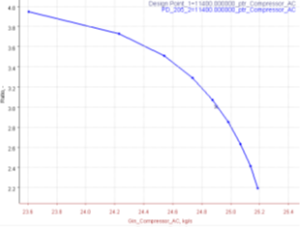
Fig [1] Compressor map after stability range adjustment

Fig[2] Compressor view
 Name: Muhammad Nouman Saleem (Pakistan)
Name: Muhammad Nouman Saleem (Pakistan)
Topic: Megawatt scale axial sCO2 turbine flow path enhancements to improve off-design performance (WP3)
Academic host: Politecnico di Milano (Italy)
Industry host: Baker Hughes (Italy)
Secondment: Easy Energy (Italy)
Academic Supervisors: Prof. Giacomo Persico, Dr. Andreas Werner
Short Bio: Welcome, Meet Muhammad Nouman Saleem, a Mechanical Engineering graduate from the National University of Sciences and Technology (NUST), Pakistan (July 2020). Following graduation, I worked as a Graduate Trainee Engineer at 560 MW Combined Cycle Power Plant for 01 Year. In September 2021, I secured the French Government Excellence Scholarship for Climate Change, embarking on a Master’s in Energy Engineering at IMT Atlantique (Ecole des Mines de Nantes), Nantes, France.
In October 2023, I joined Horizon Europe Marie Sklodowska Curie Action – ISOP Project as a Doctoral Researcher at Politecnico di Milano, Italy. My Doctoral Research focuses on “Optimizing the flow path of Megawatt Scale Axial sCO2 Turbines for enhanced off-design performance”.
Beyond work, I devote my free time to learning languages (Italian, French), exploring geopolitical documentaries, cooking, watching cricket, and playing indoor games (Table Tennis).
Feel free to connect with me on LinkedIn for collaboration or discussions.
Current activities and progress updates
Research Objective
sCO₂ turbines, modeled on traditional axial-flow steam turbine design practices, often rely on empirical loss models developed for steam turbines. The objective of this study is to investigate technical relevance of existing convention steam turbine design practices for enhancing off-design performance of low aspect ratio (0.5 – 1.0), multistage axial sCO₂ turbine for integration with SMRs and CSP.
Challenges
- Compact machine, blades with aspect ratio below 1.0 (10 x smaller than conventional steam turbine)
- Lack of experimental data for sCO₂ turbine to validate low fidelity modeling results
Status of Research
- Comparison of sCO₂ turbine aerodynamic losses estimate by low and high fidelity modeling techniques
- Investigation of secondary flows in low aspect ratio axial sCO₂ turbine
- Design of seals to reduce leakage flow across axial sCO₂ turbine blade
Research Outcome
- sCO2 Europe 2025: Low- and high-fidelity modeling of the flow in a multi-stage axial turbine for supercritical carbon dioxide power systems
- ASME IGTI 2025: An investigation of three-dimensional and unsteady flow in a multistage axial sCO2 turbine.
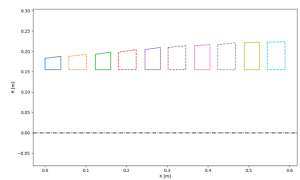
Meridional cross section of axial sCO₂ turbine
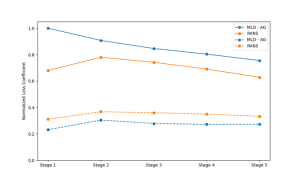
Normalized Energy Loss Coefficient comparison between low and high fidelity modelling techniques

Static entropy contour across turbine meridional cross-section signifying development of aerodynamic losses
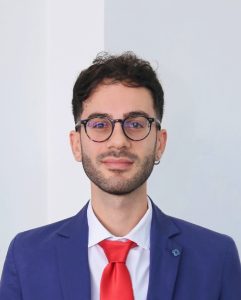
Name: Davide Dioguardi (Italy)
Topic: Fundamental study of pseudo-condensation of sCO2 (WP3)
Academic host: University of Stuttgart (Germany)
Industry host: Técnicas Reunidas (Spain)
Secondment: Fives Cryo (France)
Academic Supervisors: Prof. Joerg Starflinger, Mr. Jakub Bronik
Short Bio: Ciao! I’m Davide, a 24-year-old Italian student from Partinico, a village not so far from Palermo, in Sicily. I always had a strong interest in the fight against climate change and I firmly believe that the energy transition is key to ensuring a safe future for our world. For these reasons I’ve embarked on a journey in energy engineering, with a focus on renewable sources.
I like to learn and discover new things and dive myself into new experiences. Now I’m at the beginning of my PhD as part of ISOP project and I hope to contribute to technological innovation in energy with the use of sCO2 as a working fluid.
Outside of academic life I’d say I’m a chill guy who loves to spend his free time watching TV series and movies, listening to music and exercising. Growing up in an island, I’ve always liked the sea and swimming. I love languages, and beyond my native languages (Italian and Sicilian), I speak both English and Spanish.
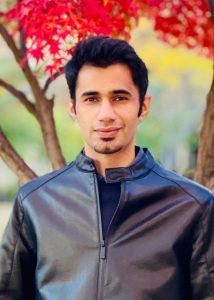
Name: Ahmad Ali Awais (Pakistan)
Topic: Numerical investigation of mixing process in headers of sCO2 heat exchangers (WP3)
Academic host: University of Stuttgart (Germany)
Industry host: Fives Cryo (France)
Secondment: Técnicas Reunidas (Spain)
Academic Supervisors: Prof. Joerg Starflinger
Short Bio: Ahmad Ali Awais, a dedicated Mechanical Engineer and aspiring researcher, excels in overcoming complex Computational Fluid Dynamics (CFD) problems. Ahmad earned his Bachelor’s degree in Mechanical Engineering from the Institute of Space Technology (IST), Islamabad, and a Master’s degree in Mechanical Engineering and Energy Systems from Kyungpook National University, South Korea, graduating with top honors and receiving prestigious scholarship awards.
His research focuses on the thermal performance optimization of mini/microchannel heat exchangers and printed circuit heat exchangers (PCHE’s) for supercritical CO2 Brayton power cycles. This research has resulted in numerous publications on heat exchangers, supercritical CO2 cycles, and nanofluid applications.
Ahmad is also dedicated to promoting sustainable engineering practices and has actively volunteered in initiatives like the UMEED welfare organization, which aims to foster positive societal change.
Now, Ahmad has joined the Institute of Nuclear Technology and Energy Systems (IKE) at the University of Stuttgart, Germany as a Marie Curie doctoral candidate in energy systems for the ISOP project. He is investigating the mixing process in the distributor headers of supercritical CO2 heat exchangers.
Outside of his professional work, Ahmad enjoys exploring new destinations, diving into a good book, watching sports, and engaging in multiplayer online battle arena games with friends.
Feel free to explore ISOP Project’s page on LinkedIn for further details.
Current activities and progress updates
In earlier phases, Ali successfully validated his numerical model for conjugate heat transfer in mini-channel heat exchangers using experimental data from the SCARLETT facility at IKE, University of Stuttgart (https://www.ike.uni-stuttgart.de/en/research/sco2/scarlett/). His current work involves simulations of a mockup design for the baseline Printed Circuit Heat Exchanger (PCHE), investigating flow distribution within CO2 channels. This research is crucial in improving the thermal and hydraulic performance of sCO2 systems, a key component for advanced energy applications.
Collaboration with industrial partners Fives – Energy | Cryogenics and Técnicas Reunidas is enabling the practical application of these findings to further enhance the efficiency and reliability of heat exchanger technologies.
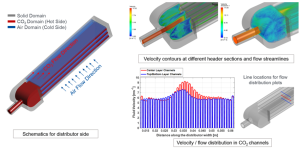

Name: Mayra Akhtar (Pakistan)
Topic: Advancing the durability of polymeric parts and coated components in sCO2 power systems (WP4)
Academic host: Instituto Superior Tecnico (Portugal)
Industry host: CiTD (Spain)
Secondment: Baker Hughes (Italy)
Academic Supervisors: Prof. Fatima Montemor, Dr. Maryna Taryba
Short Bio: Mayra Akhtar, a Mechanical Engineer and passionate changemaker, leverages her expertise to create impactful solutions for global challenges. Mayra graduated Mechanical Engineering studies, with distinction, merit scholarship, and campus and institute gold medals. She pursed her Master’s in Design and Manufacturing Engineering from National University of Science and Technology (SMME NUST), Pakistan. More than just an engineer, she is a dedicated advocate for sustainability. Through platforms like the Movers Programme and OMLAS, she raised awareness of UN Sustainable Development Goals (SDGs). Now, as a Marie Curie PhD researcher at Técnico, she is fully immersed in developing cutting-edge anti-corrosion coatings for her ISOP project, funded by the EU’s Horizon Europe program. This research not only aligns with her passion for sustainability but also demonstrates her commitment to making a real difference on a global scale. In addition to her academic pursuits, she is passionate about cooking, exploring new places and fostering connections with others. For more queries feel free to contact on LinkedIn!
Current activities and progress updates
As the energy sector shifts towards cleaner, more efficient power generation methods, supercritical CO2 (sCO2) power systems are emerging as a promising solution. However, the longevity of polymeric parts and coated components remains a significant challenge due to corrosion and material degradation in these extreme environments.
To address this, cutting-edge research is focusing on:
Corrosion-Resistant Coatings: Exploring innovative coatings for steel plates to withstand the harsh conditions of sCO2, enhancing protection and durability.
Self-Healing Polymers: Investigating self-healing technologies to minimize mechanical damage, preventing the formation of voids and cracks in key components.
Advanced Polymer Matrices: Identifying the most suitable polymer matrix for high temperature corrosion resistance in sCO2 environments, ensuring compatibility with the chosen coating and providing optimal mechanical properties. The coating chosen for this purpose is organic polysilazane.
By advancing these technologies at ISOP, we aim to push the boundaries of material durability in sCO2 power systems, ensuring their efficiency and sustainability for years to come.
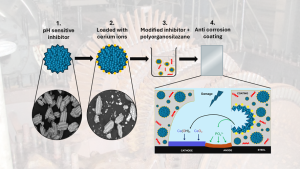
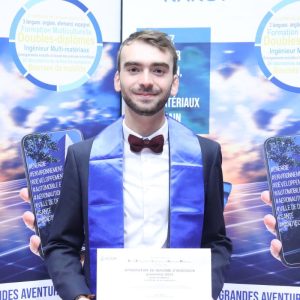 Name: Jules Aeby (France)
Name: Jules Aeby (France)
Topic: Advancing the durability of corrosion resistant alloys for sCO2 power systems (WP4)
Academic host: Instituto Superior Tecnico (Portugal)
Industry host: CiTD (Spain)
Secondment: Rosswag (Germany)
Academic Supervisors: Prof. Fatima Montemor, Dr. Joao Salvador Fernandes
Short Bio: My name is Jules Aeby, I’m 23 and I’m from Remiremont in France. I’m a doctoral student and I am taking part in this great ISOP project. My thesis is on the high-temperature degradation of corrosion-resistant alloys for heat exchangers in the presence of supercritical CO2. I am currently at the Insituto Superior Técnico (IST) in Lisbon and will be doing the second part of my thesis at the CITD in Seville. I have a master’s degree in materials engineering from the EEIGM (European School of Materials Engineering) in Nancy, France. I was able to spend several semesters abroad (Barcelona, Sao Paulo), which taught me a lot about the world and about myself. Alongside my interest in metallurgy, I’m passionate about music, playing the piano and composing. I love mountain sports and sharing the most important moments of my life with those closest to me.
 Name: Mohamed Khaled (Egypt)
Name: Mohamed Khaled (Egypt)
Topic: Additive manufacturing technologies of heat exchangers (WP3)
Academic host: University of Stuttgart (Germany)
Industry host: CiTD (Spain)
Secondment: Rosswag (Germany)
Academic Supervisors: Prof. Joerg Starflinger
Short Bio: I am Mohamed Khaled, a dedicated researcher from Alexandria, Egypt, currently pursuing my PhD at the MPA University of Stuttgart, focusing on additive manufacturing for heat exchangers. My academic journey began with a Bachelor’s degree in Mechanical Engineering at Pharos University in Alexandria (PUA) with cooperation from The Royal Institute of Technology (KTH) in Stockholm, Sweden, followed by a Master’s in Production Science and Management at Graz University of Technology (TU Graz), where I developed a keen interest in innovative manufacturing processes. Beyond my technical pursuits, I am passionate about exploring the intersections of engineering and sustainability. In my free time, I enjoy diving into local culture, discovering new places, and engaging in outdoor activities like hiking and cycling. I believe that scientific inquiry thrives on curiosity and collaboration, and I am eager to connect with fellow researchers to push the boundaries of what’s possible in engineering.
Current activities and progress updates
Additive manufacturing (AM) technologies are at the forefront of advancing the design and fabrication of heat exchangers (HX) for innovative applications in supercritical carbon dioxide (sCO2) power systems. The sCO2 cycle addresses these limitations by leveraging the unique properties of carbon dioxide in its supercritical state, offering compact, efficient, and versatile power generation solutions.
The project ISOP (Innovation in Supercritical CO2 Power Systems) focuses on multiple objectives aimed at harnessing AM technologies to optimize HX designs for sCO2 power systems. The first objective is to evaluate design methodologies and geometry optimization through advanced simulations, targeting enhancements in thermal and mechanical performance. Simulations will explore various configurations to identify optimal designs that maximize heat transfer efficiency while maintaining structural integrity under the extreme operating conditions of sCO2 systems. These include high temperatures, internal pressures, and corrosive environments.
Additively manufactured heat exchangers with gyroid structures represent a cutting-edge development in thermal management systems. Gyroid structures, categorized as Triply Periodic Minimal Surfaces (TPMS), have gained prominence due to their unique properties. TPMS are mathematically defined surfaces that minimize mean curvature, offering exceptional mechanical strength and high surface area-to-volume ratios while maintaining lightweight characteristics. Single gyroid and multiple gyroid cores heat exchangers are to be printed and compared in terms of the printing complexity, mechanical strength, heat transfer rate and efficiency. Here in Figure (1) is the CAD model of single and multiple cores heat exchanger.

Figure (1): (a) Single core heat exchanger (b) Multiple core heat exchanger.
Testing heat exchangers is critical to ensuring their reliability and performance in real-world applications. Three key tests are commonly performed. Pressure cycle test is important to evaluate the structural integrity and performance of the heat exchanger under varying pressure conditions, simulating the stresses experienced during its service life. Thermal efficiency test measures the effectiveness of heat transfer between fluids, identifying any performance inefficiencies under specific operating conditions. Lastly, leakage test detects and assesses any potential leaks within the unit, ensuring the integrity of the system and preventing issues such as fluid loss, contamination, or safety hazards during operation. Figure (3) represents a schematic for the test plan.

Figure (3): Heat Exchanger test scheme.
Moreover, Python coding is used in this project as a versatile programming language that can be used to develop a Graphical User Interface (GUI) for calculating the heat transfer rate in a heat exchanger. A typical Python GUI for this application allows users to input parameters such as fluid temperatures, mass flow rates, and specific heat capacities as shown in Figure (4).
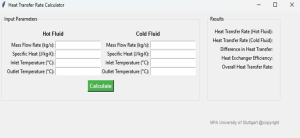
Figure (4): Heat Transfer Rate Calculator Input GUI.
The program then displays the calculated heat transfer rate, and efficiency as shown in Figure (5). In addition, temperature profiles for both cold and hot fluids are graphically represented.
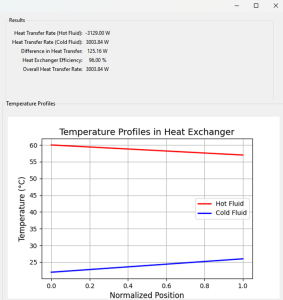
Figure (5): Heat Transfer Rate Calculator Output GUI.
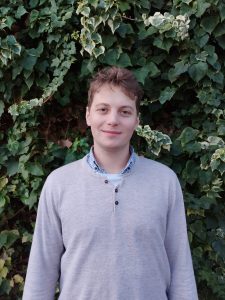 Name: Matyas Junek (Czech Republic)
Name: Matyas Junek (Czech Republic)
Topic: Utilisation of CO2 mixtures to enhance the performance of supercritical Carbon Dioxide systems (WP1)
Academic host: Politecnico di Milano (Italy)
Industry host: RPOW (Spain)
Secondment: Aalborg CSP (Denmark)
Academic Supervisors: Prof. Giampaolo Manzolini, Prof. Giacomo Persico
Short Bio: I come from a small town in the Czech Republic. My passion for physics and technology led me to Czech Technical University in Prague where I obtained my bachelor’s degree at the Faculty of Mechanical Engineering. During my bachelor studies, I became interested in energy and nuclear energy in particular. Thus, the logical step for me was to sign up for the Nuclear Power Devices Master’s program. There I learned about supercritical CO2 cycles, and I started working in this field. Besides my topic, I like reading news and papers about science and technology in general, especially about astronomy, nuclear fusion devices, quantum mechanics, and particle physics. As for my hobbies, I enjoy canoeing and fighting sports. Both of those activities require a clean head and that is a nice change after work. I also enjoy playing board games from time to time. I hope I will be able to contribute to the scientific community and expand mankind’s knowledge at least a little bit and I will work hard to achieve this goal.
Current activities and progress updates
The usage of CO2 mixtures can lead to improved performance of power cycles with respect to pure CO2. The main advantage of CO2 mixtures is shift of the critical point and especially of the critical temperature. The critical temperature increase allows to keep the benefit of reduced compression work even in hot environments. Usage of blended CO2 can lead to trans-critical cycle configuration.
The CO2 mixtures offer better performance especially in hot environments (deserts with no cooling water). However, using them brings some new challenges and limitations. It is crucial to identify thermodynamic properties of the dopant, and their effect on health, environmental and safety. Additionally, it is important to prevent significant or sudden composition shift of the working fluid. Because the power cycle is usually trans-critical, certain level of subcooling must be achieved to prevent damages to the pump. It is obvious that to ensure seamless operation of trans-critical cycles with CO2 mixtures, detailed off-design analysis is needed.
That is the reason I have been developing models and codes for off-design analysis with my colleagues at Politecnico di Milano and with collaboration with industrial partners. The models have been used within the scope of the DESOLINATION project. The project aims to build and operate power plant with CO2/SO2 mixture and is currently in the design phase. The main outcomes of our simulations are identifying operational limitations and conditions and contributing to development of a control strategy. We have submitted a journal paper on off-design analysis of the DESOLINATION plan.
The mentioned models have also more general usage. I am currently caring out research to identify the most suitable condenser configuration in trans-critical power cycles with CO2 mixtures in terms of operability and controllability.
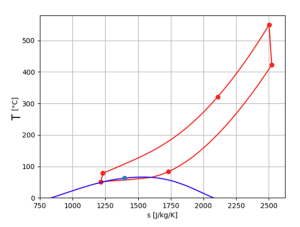
T-s diagram of trans-critical cycle with CO2 mixture.
 Name: Adonis Constantinidis Brevi (Argentina)
Name: Adonis Constantinidis Brevi (Argentina)
Topic: Innovative turbine designs for enhanced flexibility of megawatt scale axial sCO2 turbines (WP3)
Academic host: Universidad de Sevilla (Spain)
Industry host: Siemens Energy (Germany)
Secondment: SoftInWay (Switzerland)
Academic Supervisors: Prof. David Sánchez, Prof. Lourdes García
Short Bio: I’m Adonis Constantinidis Brevi, a twenty-four-year-old mechanical engineer from Argentina. I take pride in earning my bachelor’s degree from Instituto Balseiro (IB) in Argentina.
My journey at IB led me to delve into a thesis focused on developing a novel method for uranium enrichment for non-war purposes. This research was part of the LASIE project under the Comisión Nacional de Energía Atómica in San Carlos de Bariloche, Argentina.
Outside the realm of engineering, I’m a naturally curious and proactive individual. Learning, for me, isn’t just a checkbox; it’s a thrilling adventure. I’m all about pushing my limits, absorbing knowledge, and enjoying the journey along the way.
Away from work, you’ll find me cheering for football, with a special enthusiasm for watching Messi in action (as any good Argentinian would).
Eager to contribute to our collective knowledge tapestry, I’m excited to be part of this journey!
Current activities and progress updates
Supercritical CO₂ (sCO₂) technology has emerged as a promising solution to enhance network flexibility due to its high efficiency and compact design. However, a significant knowledge gap remains regarding part-load phenomena, such as the windage effect, which can lead to unexpected losses, thermal issues, and mechanical challenges in turbomachinery. Understanding and mitigating these effects is crucial to optimizing sCO₂ cycle performance and ensuring reliable operation across varying load conditions.
The research began with a comprehensive literature review to establish a solid foundation on sCO₂ turbine performance and part-load operation. As part of this process, a turbine mean-line code was developed and validated using data from the CO₂OLHEAT project, not only providing a reliable tool for turbine design and performance predictions but also serving as a valuable learning experience in turbomachinery modelling. Then, an investigation and review of the windage effect was carried out, recognizing its importance due to its potential impact on efficiency, thermal management, and mechanical integrity in sCO₂ turbines operating at part-load conditions. Given the complexity of this phenomenon, the decision was made to transition to KRAWAL-modular, an in-house tool developed by Siemens Energy, as it offers a more comprehensive and advanced modeling framework. A learning period with this software was undertaken, enabling a more detailed approach to turbomachinery behaviour.
Currently, the first part-load analyses using KRAWAL are being conducted, aiming to enhance the understanding of windage losses and their consequences in flexible sCO₂ turbine operation. The current study aims to determine how and when the windage effect becomes significant in sCO₂ turbines operating under part-load conditions. Understanding the thresholds at which this phenomenon starts to impact performance is crucial for developing strategies to mitigate its adverse effects. By analyzing different operating scenarios, the research seeks to identify design or operational solutions that can minimize windage losses and thermal issues, ensuring that the turbine maintains high efficiency and mechanical integrity. This knowledge will contribute to optimizing turbine performance and enhancing the flexibility of sCO₂ power cycles.
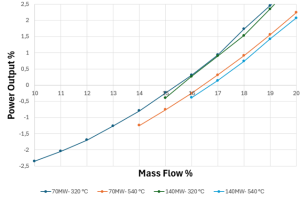
Power Output % vs. Mass Flow % for different turbine designs (70𝑀𝑊 and 140𝑀𝑊) with the different temperature inlet T0 (540 º𝐶 , 320 º𝐶).
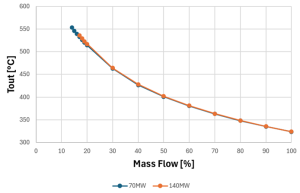
Outlet Temperature vs. Mass Flow for different turbine designs (70𝑀𝑊 and 140𝑀𝑊) with the same temperature inlet (𝑇0=540 º𝐶).
